Abstract
Earthquakes cause a huge number of landslides and alter the regional landslide risk distribution. As a result, after a significant earthquake, the landslide susceptibility maps (LSMs) must be updated. The study goal was to create seismic landslide susceptibility maps containing landslide causative variables which are adaptable to great changes in susceptibility after the Jiuzhaigou earthquake (MS 7.0) and to perform a rapid update of the LSM after the earthquake by means of the distributed scatterer interferometric synthetic aperture radar (DS-InSAR) technique. We selected the territory of Jiuzhaigou County (southwestern China) as the study region. Jiuzhaigou is a world-renowned natural heritage and tourist area of great human and ecological value. For landslide susceptibility mapping, we examined the applicability of three models (logistic regression, support vector machine, and random forest) for landslide susceptibility mapping and offered a strategy for updating seismic landslide susceptibility maps using DS-InSAR. First, using logistic regression, support vector machine, and random forest techniques, susceptibility models of seismic landslides were built for Jiuzhaigou based on twelve contributing variables. Second, we obtained the best model parameters by means of a Bayesian network and network search, while using five-fold cross-validation to validate the optimized model. According to the receiver operating characteristic curve (ROC), the SVM model and RF model had excellent prediction capability and strong robustness over large areas compared with the LR models. Third, the surface deformation in Jiuzhaigou was calculated using DS-InSAR technology, and the deformation data were adopted to update the landslide susceptibility model using the correction matrix. The correction of deformation data resulted in a susceptibility class transition in 4.87 percent of the research region. According to practical examples, this method of correcting LSMs for the continuous monitoring of surface deformation (DS-InSAR) was effective. Finally, we analyze the reasons for the change in the revised LSM and point out the help of ecological restoration in reducing landslide susceptibility. The results show that the integration of InSAR continuous monitoring not only improved the performance of the LSM model but also adapted it to track the evolution of future landslide susceptibility, including seismic and human activities.
1. Introduction
The earthquake-induced landslide is one of the most catastrophic geological hazards, capable of causing far more human casualties and serious property damage than the earthquake itself [1,2]. After the Jiuzhaigou earthquakes (MS 7.0) in recent years, multiple strong seismic landslides caused huge losses, including infrastructure and buildings [3,4]. Furthermore, Jiuzhaigou is a world-famous scenic area and tourist destination, and the landslides there caused even more damage than in other mountainous areas [5]. Xu et al. analyzed co-seismic landslides and updated the geologic hidden trouble database of landslides in Jiuzhaigou [6]. Liao et al. investigated landslides using remote sensing data after the earthquake [7]. These landslide databases made it possible for the analysis of landslide susceptibility. Landslide susceptibility maps (LSMs) are important tools for earthquake prevention and disaster reduction, and they can help decision-makers with infrastructure plans [8,9,10]. Therefore, assessing landslide susceptibility in this area and updating the distribution map of landslide susceptibility in earthquake areas are critical for developing earthquake relief and related policies.
LSMs use geomorphology, environmental factors, and landslide investigation to predict landslide occurrence. LSM models can be constructed using several methodologies, including machine learning and statistical methods, which are frequently performed using Geographic Information Systems (GIS) [11,12]. In recent years, many machine learning and statistical methods had been developed and applied to LSM, including the weights of evidence, support vector machine algorithms, decision trees, and convolutional neural networks [13]. These LSM models are usually considered time-invariant because of the absence of multitemporal data and the invariance of the influencing factors [14].
However, landslides are uncertain and their susceptibility shows dynamic changes with natural conditions, especially after earthquakes and during the rainy season [15]. The increase in earthquake-induced landslide susceptibility cannot currently be updated over time, which reduces the effectiveness and reliability of the LSM. Relevant scholars had taken the following measures to maintain the timeliness of landslide susceptibility. Some studies used physically based models to update landslide susceptibility, while others upgraded the process with the rainfall model [16,17]. Such methods, however, were often limited to specific landslides. In addition, these updating methods must continue to obtain detailed ground data, making it difficult to complete a wide range of landslide susceptibility monitoring [18]. Remote sensing data have the advantages of high accuracy, wide range, and repeatable monitoring. The use of remote sensing data for regional landslide susceptibility studies could address the limitations of physical models [19,20].
Spatial synthetic aperture radar (SAR) has been utilized extensively for geohazard investigations including landslides, debris flows, and ground subsidence [21,22,23]. In recent years, many studies have applied persistent scatterer InSAR (PSInSAR) and Small baselines subset InSAR (SBAS) to monitor various landslides all over the world, including in Mao County, the Italian mountains, and Yellowstone National Park [24,25,26]. PS-InSAR has been proven to monitor landslide deformation, which could help to improve landslide monitoring and landslide susceptibility assessments.
As mentioned above, InSAR technology allows for the rapid monitoring of surface deformation in post-earthquake areas, and the resulting changes in surface deformation before and after the earthquake can be used to rapidly update seismic landslide susceptibility maps. In addition, with the continuous monitoring of multi-time InSAR (MT-InSAR) data, they could be utilized to continuously update landslide susceptibility in the study area. Oliveira and Hussain each applied the PS-InSAR technique to the assessment of landslide susceptibility, verified the accuracy, and assessed the merits of this method [27,28]. In addition, Ciampalini et al. optimized the LSM model with PSInSAR data, reducing the false negative rate in the LSM [29]. However, there are few studies that applied these techniques to a continuous update method of LSM after earthquakes.
In the research, to determine LSM in the area, twelve criteria were considered: Normalized Difference Vegetation Index (NDVI), rainfall, land use and land cover (LULC), elevation, distance from a fault, slope, aspect, surface curvature, stratigraphic lithology, topographic water index (TWI), and distance from a river. The landslide dataset included pre-earthquake and earthquake-induced landslides and randomly sampled the same non-landslide points as the landslide dataset. Next, the LR, SVM, and RF models were used to predict the landslide susceptibility of the study area and obtain an optimal preliminary LSM. Then, distributed scattering synthetic aperture radar interferometry technology (DS-InSAR) was employed to identify landslide deformation in the study area, and an updated matrix was created to rectify landslide susceptibility. Finally, we compared the change in landslide susceptibility after the modification. There was a general trend of high to low landslide susceptibility with distance in residential areas due to rainfall, human activity, and other factors. However, in some places in the Jiuzhaigou town and Zhangzha Town, landslide susceptibility was increasing, which may be the result of human activity. At the same time, landslide susceptibility in the Jiuzhaigou Scenic Area has been significantly reduced as a result of ecological restoration efforts. Last, we discuss the causes of this phenomenon and give some suggestions.
2. Materials and Methods
2.1. Study Area and Landslide Impact Factors
In this research, Jiuzhaigou County was investigated, which covers the northwest of Sichuan province. The research area covers an area of 642.97 km2 (Figure 1). The research area comprises most of the Jiuzhaigou National Nature Reserve and is located between 33.12° and 33.35° N and 103.74° and 103.98° E. The area is high in the south and low in the north, with deep valleys and great differences in elevation, due to glaciers and obvious hydrological influences, ranging from 1830 to 4488 m [30]. The research region has a high stream density and a well-developed Karst landform [31]. The region has a complex geological background with a wide distribution of carbonates, and significant Karst action [32]. Jiuzhaigou is located in a climate transition zone between the wet Sichuan Basin and the semiarid Tibetan Plateau [33]. Annual precipitation ranges from 539 to 771 mm on average, with the wet season accounting for more than 80% of total precipitation [34]. On 8 August 2017, the MS 7.0 earthquake struck the Jiuzhaigou country, resulting in a number of co-seismic landslides. These landslides were mostly shallow rockslides and rockfalls, according to field surveys conducted by Fan et al. [4,6], which seriously damaged roads, blocked rivers, and closed scenic areas. Some landslides occurred in the area after the earthquake, and landslide susceptibility changed [35,36].
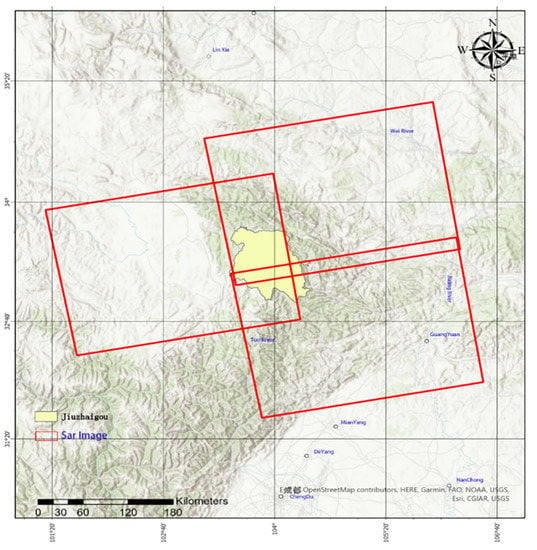
Figure 1.
Jiuzhaigou area and SAR images.
In order to obtain the LSM of the area, SAR data, optical remote sensing data, geographical data, landslide impact factors, and landslide inventories were applied to this study [37,38,39]. Table 1 and Table 2 describe the source, type, and purpose of these data. The coverage region of Sentinel-1 SAR scenarios is depicted in Figure 1. Between 2017 and 2020, we used 82 descending track SAR images from Sentinel-1 satellites, spanning the research region in Jiuzhaigou. Landslide inventories, which were often derived via surface surveys and remote sensing identification, represented the spatial distribution and scale of landslides in the region [40,41,42]. The landslide inventory included the geological survey report (provided by the Sichuan Institute of Ecological Restoration of Land Space and Geological Disaster Prevention) and earthquake-induced landslide (EIL) locations visually interpreted by Xu Chong et al. (Provided by National Cryosphere Desert Data Center) [43]. Figure 2 shows a map of landslide locations combining the above data, including earthquake-induced landslides (red) and pre-earthquake landslides (purple). As shown in Figure 3, twelve causative factors were chosen, based on the natural conditions and data available in the study area: elevation, distance from a fault, NDVI, aspect, rainfall, topographic water index, LULC, slope, plan/profile curvature, lithology and distance from a river [44,45,46,47,48,49].

Table 1.
Data and data sources.

Table 2.
List of landslide factors and data scale and source.
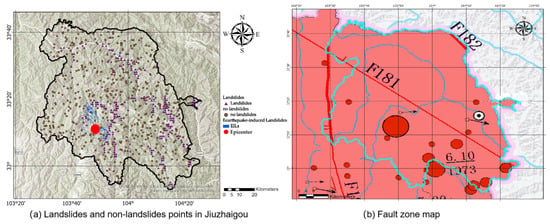
Figure 2.
Landslides and faults in Jiuzhaigou. In (a), the purple triangles are pre-earthquake landslides, and red dots are post-earthquake landslides. In (b), F180 (bottom left), F181 (middle), and F182 (top) are the Minjiang Fault, the Tazang Fault, and the Guanggaishan-Dieshan Fault, respectively.
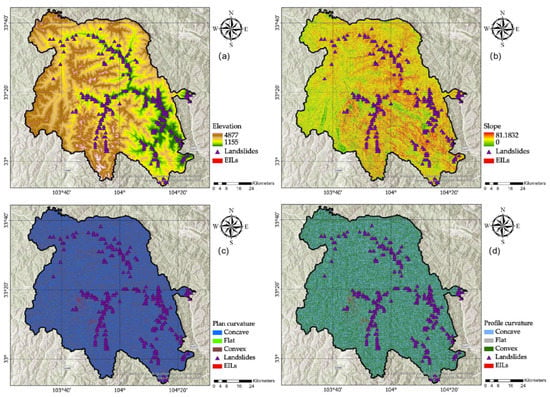
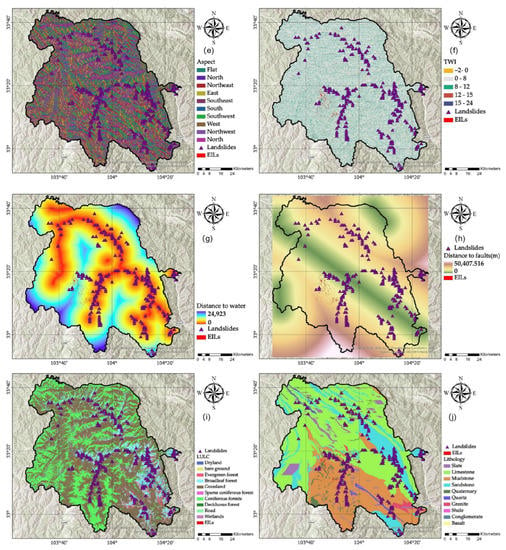
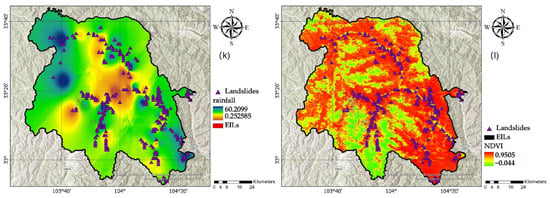
Figure 3.
Influencing factors in Jiuzhaigou. (a) Elevation; (b) slope; (c) plan curvature; (d) profile curvature; land use (e) aspect lithology; (f) TWI; (g) distance to a river; (h) distance to a fault; (i) land use and land cover; (j) lithology; (k) rainfall and (l) NDVI.
Table 2 presents the data presentation and sources for landslide factors. The slope affects the climate, vegetation distribution and potential energy of rocks in the area. The landslide probability is related to the slope angle, and different aspects influence solar radiation and water flow distribution. Profile curvature and plan curvature influence flow velocity and direction. The active faults with significant sliding displacement of rock on both sides are areas of high landslide incidence. Lithology and LULC are also important landslide factors. In the study region, mudstone and limestone were the main lithological types. The TWI is an indicator of the effects of runoff flow and volume. As an important external factor, rainfall infiltration increased the water content of the soil, raised interstitial pore water pressure and seepage pressure, reduced the angle of internal friction and increased the probability of landslides. Finally, NDVI reflects the influence of plant canopy and vegetation distribution and is often used as a landslides factor.
In addition, for training and validation, we randomly created the same number of non-landslide points as the landslide points, including 410 pre-earthquake landslide points, 97 EIL points, and 507 non-landslide points. These pre-earthquake landslides in Jiuzhaigou were mainly distributed on both sides of the Tazang Fault, and the earthquake-induced landslides were located between the Minjiang Fault and the Tazang Fault. These non-landslide points were randomly distributed, and we ensured that the distance to the landslide points was greater than 500 m. Then, the study set a 100 m buffer zone of landslides and non-landslides as their sphere of influence. The buffer distance was adjusted at 100 m based on the influential range of landslides and non-landslides. The landslide inventory was randomly divided into two portions to fit and test LSM models: 80% of landslides were used for training, and 20% of landslides were used for validation [50].
2.2. Multi-Temporal InSAR Method
In order to adjust the post-earthquake LSM using the slope deformation, multi-temporal InSAR was used to calculate surface deformation [51,52]. For efficient and swift processing of SAR data, the SAR images are processed in Figure 4. The topography of the study area was highly variable, and the surface cover consisted mainly of hills, vegetation, a small amount of agricultural land, and human-made structures. Therefore, there were few PS points in the region and dense vegetation with significant shading, which caused difficulties for traditional PS-InSAR techniques. The scatterer points in this study were divided into two parts. One was the PS points determined by thresholds of the mean to sigma ratio (MSR) (1.4) and spectral coherence (0.32) [53,54]; the number of such points was small and they were concentrated in urban areas. The other was DS points, including mountains, highways, woods, and rocks etc. To obtain more detailed regional landslide deformation, this study implemented distributed scatterer technology. This technology could significantly increase the number of observed targets in the region so as to obtain more accurate ground deformation information. To discover distributed scatterers, SAR data were analyzed for statistical hypothesis testing (KD test), as previously reported by Ferretti et al. [55,56].

Figure 4.
SAR processing flow, indicating the processing flow from obtaining PS/DS points to obtaining deformation.
Prior to the deformation analysis, the Delaunay triangle network was built to ensure the spatial connectivity of all permanent scatterer and distributed scatterer points [57]. On the completion of constructing the network, the process of selecting the best point set was carried out using distance and connectivity threshold. We initially chose a high-quality point set to establish a spatial backbone network by utilizing the period diagram approach to compute the linear deformation and elevation residual error for all linked edges. The region growth approach was then utilized to identify the edge generation branch network that fit the requirements based on the backbone network [58].
Then, using the corresponding spatial baseline (250 m) and temporal baseline (60 d) thresholds, the interferogram was calculated by means of the differential conjugate multiplication of the interferometric pairs. The differential interferogram was processed using adaptive filtering and the filtered interferogram was unwrapped using minimum cost flow (MCF) [59,60]. After removing the elevation phase and atmospheric phase from the phase model, multiple regression was used to estimate the deformation phase [54]. The interferometric pairs of multiple baselines were then reduced to time series using singular value decomposition (SVD) [61]. It is worth noting that the above method obtained the deformation velocity of the radar line of sight (LOS). Deformation of slope () was utilized in the study instead of as it better reflected the movement of landslides. The transfer approach was implemented according to the procedure of Bianchini et al. and Notti et al. [62,63]. Based on the satellite motion, the ground factor, and triangulation, the transformation equations can be calculated using Formula (1): the DEM calculated the aspect and slope angle, and the satellite parameter file obtained the azimuth and incidence angle.
where is the angle of satellite, is slope from the DEM, is the aspect from the DEM, is the the azimuth angle of the satellites and is the velocity of LOS, as shown in Figure 5.
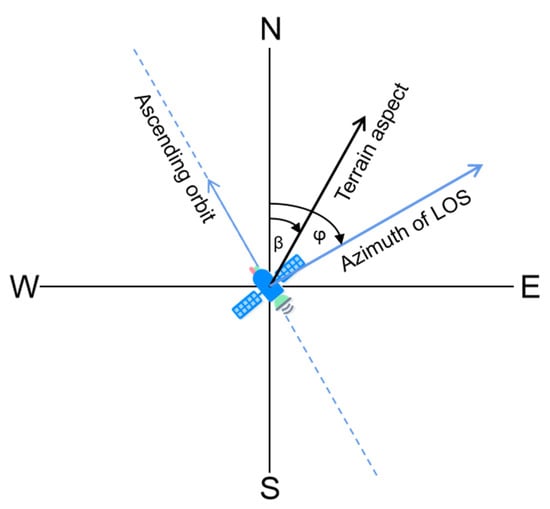
Figure 5.
A schematic diagram of the triangle of satellite and ground observations.
2.3. Landslide Susceptibility Algorithms
In this study, LR, RF, and SVM methods were applied to the generation of the LSM, and their performances were compared with accuracy, F1 scores, recall, and ROC curves. The data-driven models used whether a landslide occurred as the dependent variable and the landslide imaging factor as the input feature (independent variables). In this way, the spatial probability of the occurrence of landslides in the area was obtained.
Before calculating the LSM, this paper checked the multi-collinearity and the correlation among the influencing factors. In many studies, tolerance levels (TOL) and variance inflation factors (VIF) were utilized to examine variables [64].
According to Formula (2), the VIF and TOL were obtained by central normalization of the independent variables. The closer the VIF is to 1, the more it proves that the model-independent variables are generally free of multicollinearity, and conversely, with a VIF greater than 10, the data have severe multicollinearity. In Table 3, it can be seen that the VIF of all the factors is less than 10. In addition, we examined the correlation (Pearson index) between all factors using Formula (3). A correlation factor between factors greater than 0.75 was generally considered to indicate a linear relationship between factors [65]. These linear relationships affected the accuracy of the regression algorithm. As shown in Figure 6, the results indicate that none of the 12 factors exceeded the threshold value (>0.75). Therefore, all factors were used in the landslide susceptibility model. Combined with the factor correlation plots, it can be concluded that there is no multi-collinearity for all the landslide factors.
where is the variable of landslides factors and is the complex correlation coefficient of the variable with all other variables.

Table 3.
Multi-collinearity analysis of landslide causative factors.
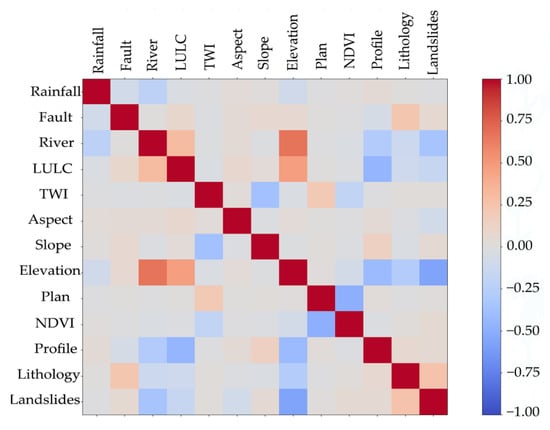
Figure 6.
Landslide factor categories and correlation for landslides. The horizontal and vertical axes indicate the landslide image factor, and the heat map indicates the magnitude of the correlation. (‘ls’ indicates landslides and non-landslides). The color bar on the right indicates the correlation value (from −1 to 1).
Three major algorithms were selected for this paper. After the previous step of feature selection, 12 categories of landslide impact factors were applied as input variables, and landslide weights (1: landslides; 0: non-lanslides) were used as dependent variables. The algorithmic models chosen are described below.
Multiple logistic regression is commonly used to assess the regression relationship between a dependent variable and several independent variables [66]. It is particularly suitable for categorical models, because it adds a suitable link function. Landslide influences were generally in a continuous or categorical form, and the maximum likelihood method was used to calculate the regression coefficients for each factor, followed by a gradient iteration to estimate the parameters, and finally we obtained a logistic multiple regression model. The probability values of landslide susceptibility were then calculated by the model for all landslide factors in the study area. In general, the probability value indicated the landslide susceptibility of the area and the closer it was to 1, the greater the landslide susceptibility. The logistic function is described as:
where is the probability of landslide occurrence and is a linear combination of casual factors:
SVM, a classical two-classification model, transforms the classification problem into the solution of a convex quadratic programming problem [67,68]. A kernel function is used to construct an optimal separation hyperplane in high-dimensional feature space to separate data samples at optimal intervals. Specifically, the objective is to construct the classification decision function f(x) on the hyperplane, select a Gaussian kernel function and penalty coefficients to construct constraints, and use the sequential minimal optimization (SMO) algorithm to find the hyperplane to obtain the classification decision function f(x).
Random forest (RF) models are one of the most popular ensemble models used in estimating LSM [69,70]. Random forest (RF) is not a stand-alone machine learning algorithm, but rather integrates the model results of all models by building multiple models on the data. It has the following parameters: estimators, criterion, max depth, max features, etc. The estimators control the number of evaluation units—the higher the number, the better the model (the presence of decision bounds). The max depth controls the maximum depth of the tree, beyond which the tree is pruned. Regarding the criterion, there are generally two options: Gini coefficient and information entropy. The max features limits the number of features that can be branched. Based on the bagging algorithm, for each node of the base decision tree, a subset of k (max features) attributes was randomly selected from the set of attributes of that node, and then the best attribute was selected from this subset for partitioning. With enough estimators, the classification result was decided by voting.
2.4. Integration
For LSM monitoring on long time scales, the use of static features alone is inappropriate and real-time modeling and analysis based on dynamic data is time-consuming and expensive. On this basis, a correction method that quickly reflects changes in the LSM is needed. A refined LSM could reduce false positives and false negatives in predicting landslides. Especially in long-term monitoring, a refined LSM could update the LSM over time according to the frequency of dynamic monitoring. This dynamic monitoring method in this study was PS-InSAR landslide deformation monitoring, and the correction method was the correction matrix.
The correction matrix included the LSM and PS-InSAR data for the landslide cells. As shown in Table 4, the values for each cell were reclassified as five classes: low; low-medium; medium; medium-high, and high. Based on the landslide deformation values, the susceptibility corrections were correspondingly set from 1 to 5. Finally, the corrected susceptibility levels were classified into six classes, 1 = low; 2 = low-moderate; 3 = moderate; 4 = moderate-high, 5 = high and 6 = very high. The principle of the correction matrix was that high deformation increases landslide susceptibility, while low deformation decreases it. For areas of high deformation and high susceptibility, the refined LSM added one level, meaning that 6 represents very high susceptibility. Thus, the refined LSM corrected for landslide susceptibility characterized by ground deformation velocity, thereby reducing the probability of false positives and false negatives. On the other hand, this method is very fast and can be kept up to date over the time series.

Table 4.
The correction matrix of dynamic landslide susceptibility maps. LSM degree is 1 = low; 2 = low-medium; 3 = medium; 4 = medium-high and 5 = high.
3. Result
3.1. PS and DS InSAR
Figure 7 presents the average deformation rates in the Jiuzhaigou area for 2017–2020, using inverse distance weight interpolation to fill in missing values and resampling to 30 m × 30 m. This is consistent with the fact that only a few cells were at high deformation rates in the three years following the earthquake, with most cells showing very little deformation. In areas of high deformation, it is often associated with artificial activity.
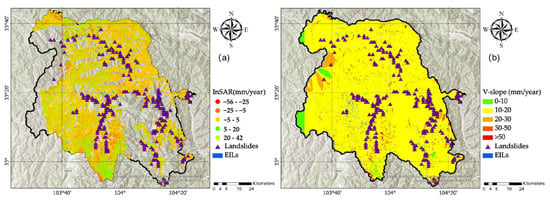
Figure 7.
(a) InSAR deformation of study area. (b) The index of , where each cell is 30 m × 30 m, and reverse directional deformation leading to the landslide is considered to be 0.
The 2017 earthquake, and subsequent tectonic movements and human-made activities, produced large-scale surface deformation in the Jiuzhaigou region. Figure 7a illustrates the estimated deformation map for the SAR images. The PS points obtained by the PS-InSAR method are mainly concentrated in urban areas, such as human-made structures and exposed rock masses. Then, with the addition of DS points, reliable deformation signals were obtained not only in the urban areas but also in non-urban areas, such as mountainous and densely vegetated areas. In the study area, landslide deformation values ranged from −56 mm/year to 42 mm/year, with intense deformation concentrated on the side slopes of towns and roads. In addition, there was also relatively large deformation on hilltops due to snow and freeze–thaw. Figure 8 shows the deformation rate map for a local area of landslide, where the change in landslide YG145 was very pronounced in the period following the earthquake, and correspondingly the landslide susceptibility in this area was much greater than in the surrounding areas where the change was not as pronounced.
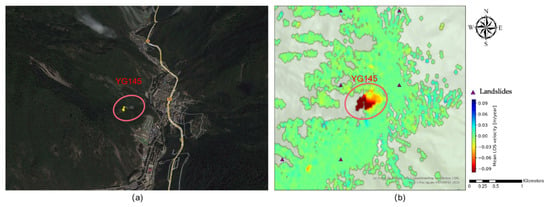
Figure 8.
(a) The optical image of YG145 landslide in Zhangzha. (b) Surface deformation results for YG145 landslide. This landslide was located at the back of the Jiuzhaigou Hotel in Zhangzha, with a maximum slope deformation greater than 100 mm/year.
3.2. The Preliminary LSM
In terms of landslide susceptibility, the study considered the conditional probability of a landslide as the landslide susceptibility. The conditional probability of a landslide was calculated from the voting score using the Softmax function, and therefore ranges from 0 to 1. Based on previous experience [63,64], landslide susceptibility had been classified into five classes: (a) low (0–0.1), (b) low-moderate (0.1–0.3), (c) moderate (0.3–0.5), (d) moderate-high (0.5–0.75) and (e) high (more than 0.75).
For the LR model and RF model, Table 5 reports the results of significant drivers for each model. According to the coefficients and important scores, we considered rainfall, fault, river, and lithology to be important factors influencing landslides in the area. Table 6 illustrates the results of the performance evaluation of each model, with RF showing good results in each metric. The area under the receiver operating characteristic curve (AUC) was used in the statistical assessment of the overall performance of the landslide model to quantitatively compare the performance of various models. The AUC values were generated for the training and test datasets, respectively. The AUC values in the training data showed the ability to map landslide susceptibility. Meanwhile, the AUC values in the test data represent the accuracy of future landslide predictions. In Figure 9, the AUC (0.9665) indicates that the random forest algorithm used achieved good results in the test set, outperforming the SVM algorithm (0.9419) and the LR algorithm (0.8769).

Table 5.
List of coefficients (LR) and important scores (RF).

Table 6.
Evaluation of each model.
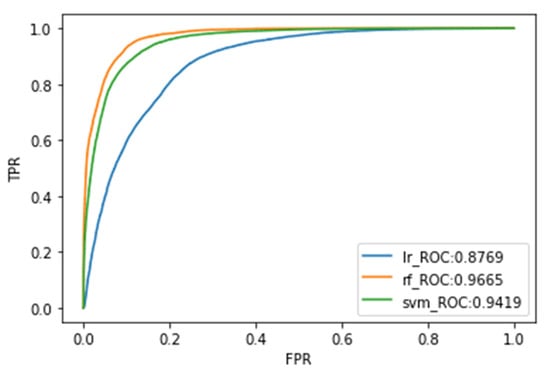
Figure 9.
The ROC of preliminary LSM models (random forest, LR and SVM are represented by orange, blue and green, respectively).
As shown in Figure 10, brief statistical analysis showed that 8.212% of cells were classified as high susceptibility, 9.778% cells as moderate to high susceptibility, 33.385% cells as moderate susceptibility, 18.899% cells as low to moderate susceptibility, and 29.725% cells as low susceptibility. Comparison of the results with the landslide inventory shows a prediction accuracy of 90.18% for landslide occurrence, indicating that the model results are reliable.
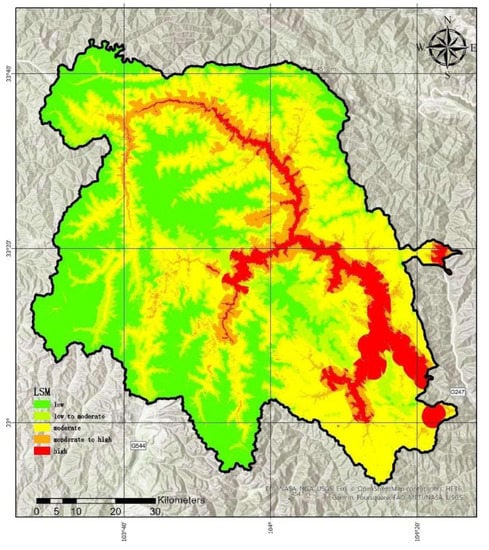
Figure 10.
The preliminary LSM (post-earthquake) produced by the proposed method, including low susceptibility, low to moderate susceptibility, moderate susceptibility, moderate to high susceptibility and high susceptibility.
In addition, the data related to landslide distribution are very different in the pre-earthquake and post-earthquake time periods due to the large number of landslides induced by the earthquake in the study area. We analyzed the difference in LSM distribution before and after the earthquake. According to Figure 11, before the earthquake, only 23% of the area was identified as high susceptibility before the earthquake, but after the earthquake, the area increased to 53% of high susceptibility. Overall, 20% of the earthquake-induced landslides occurred in areas of pre-existing high susceptibility, while 52% occurred in areas of medium and medium-high susceptibility. Only a few landslides occurred in areas of low and low to medium susceptibility, but we attributed this phenomenon to the uncertainty of the earthquake. The different distributions of earthquake-induced landslide susceptibility suggested that the pre-earthquake predictions were valid.

Figure 11.
Pre-earthquake and pro-earthquake landslide susceptibility map in EIL areas.
3.3. Refined Earthquake-Induced LSM of the Jiuzhaigou Region
The refinement of the LSM took place in the final detection of six susceptibility classes, ranging from I—very low to VI—Very High (Figure 12). This change indicated that the susceptibility corrected for InSAR data eliminated some false positive areas and increased the susceptibility values of some false negative areas. The false positive areas indicated a high initial susceptibility, but the actual surface deformation was stable and less prone to landslides. The false-negative areas had a low initial susceptibility, but the surface deformation was significant and landslides were likely to occur. In terms of landslide susceptibility, uninhabited regions were mostly characterized by very low susceptibility (27.88%), because of the very small landslide hazard and damage in these areas. Low-moderate susceptibility areas were concentrated in areas further away from roads and residential areas, accounting for 19.646% of the total area, and these areas were generally considered to have low susceptibility. Moderate and moderate-high susceptibility was found in some areas close to roads and residential areas, accounting for 32.795% and 11.159% of the total area, respectively, where a series of construction projects has led to occasional instability of the slopes, making landslide susceptibility greater. High susceptibility was spotted in the unstable slopes and earthquake-induced landslides (8.438%). Very high susceptibility was mainly observed in some extremely unstable hills and post-earthquake deformed slopes. As a whole, the Jiuzhaigou area presented moderate values, progressively increasing to moderate-high moving towards the towns. High susceptibility zones were located in seismic areas, residential areas, and roads. The Jiuzhaigou Nature Reserve, finally, presents susceptibility values ranging from low-moderate to high. The earthquake increased landslide susceptibility in the reserve, but after a series of recovery and mitigation works, the susceptibility was significantly reduced.
Compared to the preliminary susceptibility map (Figure 13), refined LSM indicated a 1.845% reduction in areas of low susceptibility and a 0.747% increase in the low-moderate susceptibility areas. The reduction in these moderate areas (0.59%) made it possible to reduce the susceptibility of areas at the edges of the slope, where deformation tends to be small, but which are classified as moderately susceptible in the initial LSM. We calculated a 1.381% increase in moderate-high susceptibility, which we interpreted as an increase in deformation of a portion of the slope close to the valley sides. This increased area (0.226%) of high susceptibility areas in the post-earthquake period may indicate that the strong deformation increased the chance of landslides. The fact that the majority of these deformations were found in populated areas and on hills on either side of the road suggested that human-made disturbances such as road construction and slope excavation had altered the strength of the slope and increased the susceptibility to landslides. There were some areas (0.082%) of very high susceptibility, particularly unstable slopes, where strong deformation showed very high susceptibility to landslide events. Figure 14 compares the susceptibility maps for these sites and the field survey maps for sites with very high susceptibility (resolution 30 m). The YG145 landslide was protected by enclosures and the Heye landslide had soil sliding. These two surveys showed that our correction for landslide susceptibility using the magnitude of slope deformation was valid and correct.
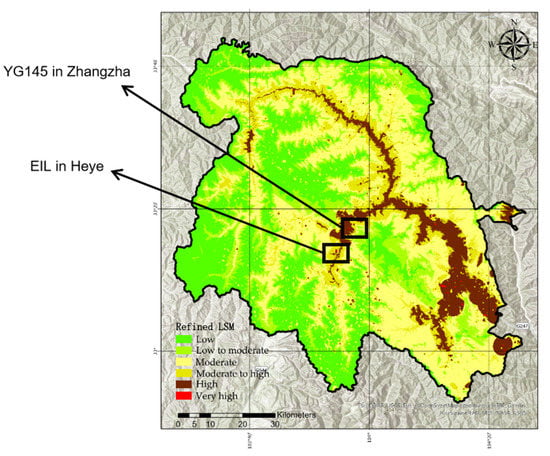
Figure 12.
The refined LSM using the InSAR result, and very high susceptibility areas (rank 6) are added to illustrate major focus areas. Black polygons indicate sites where deformation acceleration events were still being recorded; Figure 14 shows a detailed ground survey of each site with photographs.
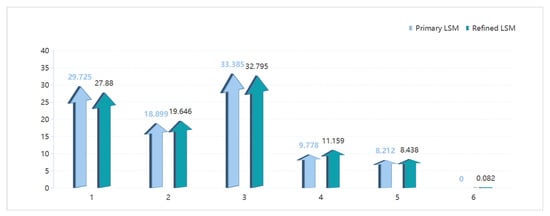
Figure 13.
Distribution of susceptibility degrees of the preliminary LSM and refined LSM. The X-axis is the degree of susceptibility, and the Y-axis is the percentage of the whole area.
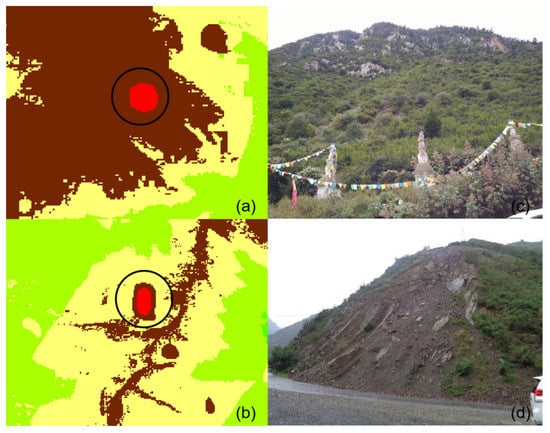
Figure 14.
Earthquake-induced landslide events in Jiuzhaigou were documented through photographs; for site location and LSM, see Figure 13. On the left is an enlarged LSM (Figure 13) for each site: (a) YG145 landslide in Zhangzha, (b) YG159 landslide in the Heye moutain. On the right, (c) and (d) are photo records of the selected EIL events (2018).
4. Discussion
Earthquakes in Karst regions quickly increase the susceptibility to landslides and spark a large number of geological hazards. In this study, the refined LSM aimed to update the susceptibility classes in the time series and decrease the number of potential false negatives using the RF model. In this study, it was possible to compare the results of various assessments of landslide susceptibility in Jiuzhaigou and provide an effective correction method for a refined LSM. A refined LSM could reduce the number of errors using only the RF model and update the susceptibility classes in the time series. This method proved to be very effective in delineating areas of different susceptibility. The MS 7.0 earthquake in this region in 2017 caused a significant increase in landslide susceptibility in the epicenter region, but the time series of regional deformation showed a gradual decrease in LSM in most of the region after the earthquake, which was associated with stress release and manual intervention. Over the past four years, a total of 270,000 trees have been replanted in the Jiuzhaigou scenic area, with a restoration and protection area of 1.72 km2, and the scenic area’s ecosystem had been effectively restored [71]. As shown in Figure 15, we compare the NDVI after ecological restoration with the NDVI during the earthquake period. The change in NDVI indicates that there is increased vegetation and that ecological restoration has had an effect. On the other hand, in the Zhangzha and Jiuzhaigou National Park, human activities have increased landslide susceptibility. This rapid update method provides the ability to dynamically update the LSM to provide a reference for planners. In addition, dynamic landslide susceptibility demonstrates that appropriate ecological protection is an effective means of reducing landslide susceptibility.
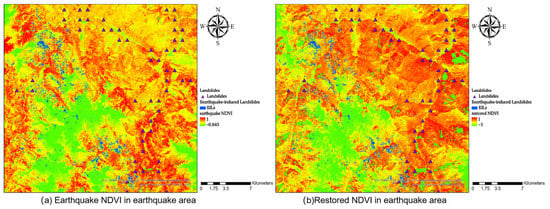
Figure 15.
Earthquake NDVI and restored NDVI. (a) is the NDVI of EIL areas between August 2017 and December 2017, and (b) is the NDVI of EIL areas between August 2021 and December 2021.
There are many factors that influence landslides, and different combinations of factors can have a profound impact on the results. In this study, the 12 influencing factors and landslide inventory were selected by experts from the Sichuan Ecological and Environmental Restoration Institute based on years of ground investigation and research, taking into account topography, river, climate, vegetation, human activity, earthquakes, and faults. In the model calculation, grid search and Bayesian methods were used to find suitable model parameters by considering the ROC, F1 score, and other indicators.
Meanwhile, in the Karst Region, difficulties including temporal decorrelation and atmospheric phase screen hindered the use of PSI techniques over multi-vegetation regions. To overcome this limitation, this research developed a distributed scatterer technique by forming an optimal interferogram network and employing spatial adaptive filtering to reduce noise and improve the density of distributed scatterers in sparsely vegetated landscapes. Despite the fact that PS/DS points from the C-band dataset had a lower density in vegetated areas than those from the L-band dataset, Sentinel data have fast revisit cycles, a simple data collecting process, and a huge image range. Using Sentinel data significantly decreased temporal decorrelation, making displacement detection possible over landslides covered in rangeland, grassland, bushes, and bare soils.
Evaluation of the models for the initial LSM and the rapidly updated LSM showed that the modified LSM could improve the susceptibility model according to the regional deformation rate. The susceptibility of areas of high deformation was adjusted upwards and vice versa. Distance from rivers was found to be a significant factor in this study. Landslide surveys recorded that the majority of landslides occurred in areas of medium to high steep slopes on both sides of the road or river, and the surveys were also consistent with the landslide inventory data. Then, corrections were established with the rate of deformation of the slopes, reducing the LSM for areas with less deformation at the base of the slope and increasing the LSM for areas with more deformation on the slope. Such corrections reduced the probability of false positives and false negatives and improved the reliability of the model.
In addition, the distribution of landslides in different situations is also an important factor affecting landslide susceptibility. A timely landslide survey could update the landslide inventory, and such landslide surveys could be carried out by means of a combination of satellite remote sensing and ground surveys, including PS-InSAR monitoring of active slopes, optical image monitoring of landslide features, and grid surveys performed by professionals.
5. Conclusions
In summary, this study addressed the LSM dynamic update problem using PS/DS-InSAR data. The model tested the performance of LR, SVM, and RF on earthquake-induced landslides and the landslide inventory, and then the optimal model was corrected using SAR deformation data. The results of the model assessment show that all three models had AUC values greater than 0.80, indicating good landslide susceptibility prediction for the three typical models. Furthermore, the results of the four statistical indicators of F1 score, recall, precision, and accuracy indicate that the RF models produced good and reasonable results and outperformed the other two models. Landslide susceptibility in the area was dynamically refined using the proposed correction method, and the change in susceptibility was evaluated four years after the earthquake. This dynamic landslide susceptibility effectively helps to reduce landslide damage and protect lives and property. In addition, the results also illustrate that landslide susceptibility in the Jiuzhaigou scenic area has greatly been reduced after some ecological restoration.
Thanks to the full time series and global coverage of Sentinel data, refined LSMs enable dynamic initial LSMs and increase the reliability and usability of landslide susceptibility information. In particular, InSAR technology demonstrated good performance in measuring slow-moving landslides. In addition, the freely available Sentinel-1 data can effectively reduce the cost of landslide susceptibility studies, making this method a good option for a large number of developing countries to carry out such studies.
Author Contributions
Conceptualization, Y.S. and C.X.; data curation, H.F.; funding acquisition, Y.S. and C.X.; investigation, Y.Z., Q.Y. and Y.Y.; methodology, H.F. and C.X.; project administration, Y.G.; software, H.F. and B.T.; supervision, Y.S. and B.T.; writing—original draft, H.F.; writing—review and editing, C.X. All authors have read and agreed to the published version of the manuscript.
Funding
This research was funded by Remote Sensing Identification and Monitoring of Geological Disaster Hazards in Sichuan Province (2020), Sichuan Research Institute of Ecological Restoration of Land Space and Geological Disaster Prevention and Control, grant number E1H2110702, and Multi-Source Remote Sensing Regional Landslide Hazard Risk Mapping and Key Landslide Fine Survey, Science and Technology Bureau of Fuzhou City, Fujian Province, grant number E1D7110100.
Institutional Review Board Statement
Not applicable.
Informed Consent Statement
Not applicable.
Data Availability Statement
Not applicable.
Acknowledgments
The authors are thankful to the Sichuan Institute of Ecological Restoration of Land Space and Geological Disaster Prevention, a Unicom (Fujian) Industrial Internet Co., Ltd.
Conflicts of Interest
The authors declare no conflict of interest.
References
- Lee, C.T.; Huang, C.C.; Lee, J.F.; Pan, K.L.; Lin, M.L.; Dong, J.J. Statistical approach to earthquake-induced landslide susceptibility. Eng. Geol. 2008, 100, 43–58. [Google Scholar] [CrossRef]
- Tanyaş, H.; Van Westen, C.J.; Allstadt, K.E.; Anna Nowicki Jessee, M.; Görüm, T.; Jibson, R.W.; Godt, J.W.; Sato, H.P.; Schmitt, R.G.; Marc, O.; et al. Presentation and analysis of a worldwide database of earthquake-induced landslide inventories. J. Geophys. Res. Earth Surf. 2017, 122, 1991–2015. [Google Scholar] [CrossRef]
- Zhao, B.; Wang, Y.S.; Luo, Y.H.; Li, J.; Zhang, X.; Shen, T. Landslides and dam damage resulting from the Jiuzhaigou earthquake (8 August 2017), Sichuan, China. R. Soc. Open Sci. 2018, 5, 171418. [Google Scholar] [CrossRef] [PubMed]
- Fan, X.; Scaringi, G.; Xu, Q.; Zhan, W.; Dai, L.; Li, Y.; Pei, X.; Yang, Q.; Huang, R. Coseismic landslides triggered by the 8th August 2017 Ms 7.0 Jiuzhaigou earthquake (Sichuan, China): Factors controlling their spatial distribution and implications for the seismogenic blind fault identification. Landslides 2018, 15, 967–983. [Google Scholar] [CrossRef]
- Hu, X.; Hu, K.; Zhang, X.; Wei, L.; Tang, J.-B. Quantitative assessment of the impact of earthquake-induced geohazards on natural landscapes in Jiuzhaigou Valley. J. Mt. Sci. 2019, 16, 441–452. [Google Scholar] [CrossRef]
- Xu, C.; Xu, X.; Zhou, B.; Shen, L. Probability of coseismic landslides: A new generation of earthquake-triggered landslide hazard model. J. Eng. Geol. 2019, 27, 1122–1130. [Google Scholar] [CrossRef]
- Cai, J.; Zhang, L.; Dong, J.; Dong, X.; Liao, M.; Xu, Q. Detection and Monitoring of Post-Earthquake Landslides in Jiuzhaigou Using Radar Remote Sensing. Geomat. Inf. Sci. Wuhan Univ. 2020, 45, 1707–1716. [Google Scholar] [CrossRef]
- Huang, Y.; Zhao, L. Review on landslide susceptibility mapping using support vector machines. Catena 2018, 165, 520–529. [Google Scholar] [CrossRef]
- Dahal, R.K.; Hasegawa, S.; Nonomura, A.; Yamanaka, M.; Masuda, T.; Nishino, K. GIS-based weights-of-evidence modelling of rainfall-induced landslides in small catchments for landslide susceptibility mapping. Environ. Geol. 2008, 54, 311–324. [Google Scholar] [CrossRef]
- Achour, Y.; Pourghasemi, H.R. How do machine learning techniques help in increasing accuracy of landslide susceptibility maps? Geosci. Front. 2020, 11, 871–883. [Google Scholar] [CrossRef]
- Chen, X.; Chen, W. GIS-based landslide susceptibility assessment using optimized hybrid machine learning methods. Catena 2021, 196, 104833. [Google Scholar] [CrossRef]
- Nguyen, V.T.; Tran, T.H.; Ha, N.A.; Ngo, V.L.; Nadhir, A.A.; Tran, V.P.; Duy Nguyen, H.; Malek, M.A.; Amini, A.; Prakash, I.; et al. GIS based novel hybrid computational intelligence models for mapping landslide susceptibility: A case study at da lat city, Vietnam. Sustainability 2019, 11, 7118. [Google Scholar] [CrossRef]
- Oshan, T.M.; Li, Z.; Kang, W.; Wolf, L.J.; Fotheringham, A.S. mgwr: A Python implementation of multiscale geographically weighted regression for investigating process spatial heterogeneity and scale. ISPRS Int. J. Geo-Inf. 2019, 8, 269. [Google Scholar] [CrossRef]
- Lombardo, L.; Tanyas, H. Chrono-validation of near-real-time landslide susceptibility models via plug-in statistical simulations. Eng. Geol. 2020, 278, 105818. [Google Scholar] [CrossRef]
- Ozturk, U. Geohazards explained 10: Time-dependent landslide susceptibility. Geol. Today 2022, 38, 117–120. [Google Scholar] [CrossRef]
- Wang, H.J.; Xiao, T.; Li, X.Y.; Zhang, L.L.; Zhang, L.M. A novel physically-based model for updating landslide susceptibility. Eng. Geol. 2019, 251, 71–80. [Google Scholar] [CrossRef]
- Luo, J.; Zhang, L.; Yang, H.; Wei, X.; Liu, D.; Xu, J. Probabilistic model calibration of spatial variability for a physically-based landslide susceptibility model. Georisk Assess. Manag. Risk Eng. Syst. Geohazards 2021, 1–18. [Google Scholar] [CrossRef]
- Hu, S.; Wang, X.; Wang, N.; Yang, D.; Wang, D.; Ma, S.; Song, Z.; Cao, M. Dynamic process, influence, and triggering mechanism of slope remodelling by landslide clusters in the South Jingyang Tableland, China. CATENA 2022, 217, 106518. [Google Scholar] [CrossRef]
- Luti, T.; Segoni, S.; Catani, F.; Munafò, M.; Casagli, N. Integration of remotely sensed soil sealing data in landslide susceptibility mapping. Remote Sens. 2020, 12, 1486. [Google Scholar] [CrossRef]
- Bachri, S.; Shrestha, R.P.; Yulianto, F.; Sumarmi, S.; Utomo, K.S.B.; Aldianto, Y.E. Mapping landform and landslide susceptibility using remote sensing, gis and field observation in the southern cross road, Malang regency, East Java, Indonesia. Geosciences 2020, 11, 4. [Google Scholar] [CrossRef]
- Strozzi, T.; Farina, P.; Corsini, A.; Ambrosi, C.; Thüring, M.; Zilger, J.; Wiesmann, A.; Wegmüller, U.; Werner, C. Survey and monitoring of landslide displacements by means of L-band satellite SAR interferometry. Landslides 2005, 2, 193–201. [Google Scholar] [CrossRef]
- Strozzi, T.; Klimeš, J.; Frey, H.; Caduff, R.; Huggel, C.; Wegmüller, U.; Rapre, A.C. Satellite SAR interferometry for the improved assessment of the state of activity of landslides: A case study from the Cordilleras of Peru. Remote Sens. Environ. 2018, 217, 111–125. [Google Scholar] [CrossRef]
- Greif, V.; Vlcko, J. Monitoring of post-failure landslide deformation by the PS-InSAR technique at Lubietova in Central Slovakia. Environ. Earth Sci. 2012, 66, 1585–1595. [Google Scholar] [CrossRef]
- Dong, J.; Zhang, L.; Li, M.; Yu, Y.; Liao, M.; Gong, J.; Luo, H. Measuring precursory movements of the recent Xinmo landslide in Mao County, China with Sentinel-1 and ALOS-2 PALSAR-2 datasets. Landslides 2018, 15, 135–144. [Google Scholar] [CrossRef]
- Bayer, B.; Schmidt, D.; Simoni, A. The Influence of External Digital Elevation Models on PS-InSAR and SBAS Results: Implications for the Analysis of Deformation Signals Caused by Slow Moving Landslides in the Northern Apennines (Italy). IEEE Trans. Geosci. Remote Sens. 2017, 55, 2618–2631. [Google Scholar] [CrossRef]
- Fadhillah, M.F.; Achmad, A.R.; Lee, C.-W. Improved Combined Scatterers Interferometry With Optimized Point Scatterers (ICOPS) for Interferometric Synthetic Aperture Radar (InSAR) Time-Series Analysis. IEEE Trans. Geosci. Remote Sens. 2022, 60, 5220014. [Google Scholar] [CrossRef]
- Oliveira, S.C.; Zêzere, J.L.; Catalão, J.; Nico, G. The contribution of PSInSAR interferometry to landslide hazard in weak rock-dominated areas. Landslides 2015, 12, 703–719. [Google Scholar] [CrossRef]
- Hussain, M.A.; Chen, Z.; Wang, R.; Shoaib, M. PS-InSAR-based validated landslide susceptibility mapping along Karakorum Highway, Pakistan. Remote Sens. 2021, 13, 4129. [Google Scholar] [CrossRef]
- Ciampalini, A.; Raspini, F.; Lagomarsino, D.; Catani, F.; Casagli, N. Landslide susceptibility map refinement using PSInSAR data. Remote Sens. Environ. 2016, 184, 302–315. [Google Scholar] [CrossRef]
- Yi, Y.; Zhang, Z.; Zhang, W.; Jia, H.; Zhang, J. Landslide susceptibility mapping using multiscale sampling strategy and convolutional neural network: A case study in Jiuzhaigou region. Catena 2020, 195, 104851. [Google Scholar] [CrossRef]
- Cao, Y.; Wang, B.; Zhang, J.; Wang, L.; Pan, Y.; Wang, Q.; Jian, D.; Deng, G. Lake macroinvertebrate assemblages and relationship with natural environment and tourism stress in Jiuzhaigou Natural Reserve, China. Ecol. Indic. 2016, 62, 182–190. [Google Scholar] [CrossRef]
- Jain, S. Karst. In Fundamentals of Physical Geology. Springer Geology; Springer: New Delhi, India, 2014. [Google Scholar] [CrossRef]
- Qiao, X.; Du, J.; Lugli, S.; Ren, J.; Xiao, W.; Chen, P.; Tang, Y. Are climate warming and enhanced atmospheric deposition of sulfur and nitrogen threatening tufa landscapes in Jiuzhaigou National Nature Reserve, Sichuan, China? Sci. Total Environ. 2016, 562, 724–731. [Google Scholar] [CrossRef] [PubMed]
- Liu, L. Factors Affecting Tufa Degradation in Jiuzhaigou National Nature Reserve, Sichuan, China. Water 2017, 9, 702. [Google Scholar] [CrossRef]
- Hu, X.; Hu, K.; Tang, J.; You, Y.; Wu, C. Assessment of debris-flow potential dangers in the Jiuzhaigou Valley following the August 8, 2017, Jiuzhaigou earthquake, western China. Eng. Geol. 2019, 256, 57–66. [Google Scholar] [CrossRef]
- Gao, S.D. Overview of tracking of Sichuan Jiuzhaigou MS 7.0 earthquake in 2017 and its post earthquake precursor anomaly summary. Prog. Geophys. 2020, 35, 1250–1260. [Google Scholar] [CrossRef]
- Modava, M.; Akbarizadeh, G.; Soroosh, M. Hierarchical coastline detection in SAR images based on spectral-textural features and global–local information. IET Radar Sonar Navig. 2019, 13, 2183–2195. [Google Scholar] [CrossRef]
- Dubovik, O.; Fuertes, D.; Litvinov, P.; Lopatin, A.; Lapyonok, T.; Doubovik, I.; Xu, F.; Ducos, F.; Chen, C.; Torres, B.; et al. A comprehensive description of multi-term LSM for applying multiple a priori constraints in problems of atmospheric remote sensing: GRASP algorithm, concept, and applications. Front. Remote Sens. 2021, 2, 706851. [Google Scholar] [CrossRef]
- Roy, J.; Saha, S.; Arabameri, A.; Blaschke, T.; Bui, D.T. A novel ensemble approach for landslide susceptibility mapping (LSM) in Darjeeling and Kalimpong districts, West Bengal, India. Remote Sens. 2019, 11, 2866. [Google Scholar] [CrossRef]
- Chen, Y.; Ming, D.; Ling, X.; Lv, X.; Zhou, C. Landslide Susceptibility Mapping Using Feature Fusion-Based CPCNN-ML in Lantau Island, Hong Kong. IEEE J. Sel. Top. Appl. Earth Obs. Remote Sens. 2021, 14, 3625–3639. [Google Scholar] [CrossRef]
- Rasyid, A.R.; Bhandary, N.P.; Yatabe, R. Performance of frequency ratio and logistic regression model in creating GIS based landslides susceptibility map at Lompobattang Mountain, Indonesia. Geoenviron. Disasters 2016, 3, 19. [Google Scholar] [CrossRef]
- Feizizadeh, B.; Roodposhti, M.S.; Blaschke, T.; Aryal, J. Comparing GIS-based support vector machine kernel functions for landslide susceptibility mapping. Arab. J. Geosci. 2017, 10, 122. [Google Scholar] [CrossRef]
- Xu, C. Distribution of landslide data from the Ms7.0 earthquake in Jiuzhaigou County, Sichuan Province on 8 August 2017. National Cryosphere Desert Data Center. 2022. Available online: http://www.ncdc.ac.cn/portal/metadata/4716fd91-2fd4-4e30-a9a1-7931a0d0b1b2 (accessed on 24 April 2022).
- Shan, W.; Jin, X.; Ren, J.; Wang, Y.; Xu, Z.; Fan, Y.; Gu, Z.; Hong, C.; Lin, J.; Zhou, Y. Ecological environment quality assessment based on remote sensing data for land consolidation. J. Clean. Prod. 2019, 239, 118126. [Google Scholar] [CrossRef]
- Pawluszek, K.; Borkowski, A. Impact of DEM-derived factors and analytical hierarchy process on landslide susceptibility mapping in the region of Rożnów Lake, Poland. Nat. Hazards 2017, 86, 919–952. [Google Scholar] [CrossRef]
- Persichillo, M.G.; Bordoni, M.; Meisina, C. The role of land use changes in the distribution of shallow landslides. Sci. Total Environ. 2017, 574, 924–937. [Google Scholar] [CrossRef] [PubMed]
- Irigaray, C.; Lamas, F.; El Hamdouni, R.; Fernández, T.; Chacón, J. The Importance of the Precipitation and the Susceptibility of the Slopes for the Triggering of Landslides Along the Roads. Nat. Hazards 2000, 21, 65–81. [Google Scholar] [CrossRef]
- Abraham, M.T.; Satyam, N.; Pradhan, B.; Alamri, A.M. Forecasting of landslides using rainfall severity and soil wetness: A probabilistic approach for Darjeeling Himalayas. Water 2020, 12, 804. [Google Scholar] [CrossRef]
- Ohlmacher, G.C. Plan curvature and landslide probability in regions dominated by earth flows and earth slides. Eng. Geol. 2007, 91, 117–134. [Google Scholar] [CrossRef]
- Wubalem, A.; Meten, M. Landslide susceptibility mapping using information value and logistic regression models in Goncha Siso Eneses area, northwestern Ethiopia. SN Appl. Sci. 2020, 2, 807. [Google Scholar] [CrossRef]
- Necula, N.; Niculiță, M.; Fiaschi, S.; Genevois, R.; Riccardi, P.; Floris, M. Assessing Urban Landslide Dynamics through Multi-Temporal InSAR Techniques and Slope Numerical Modeling. Remote Sens. 2021, 13, 3862. [Google Scholar] [CrossRef]
- Shi, X.; Yang, C.; Zhang, L.; Jiang, H.; Liao, M.; Zhang, L.; Liu, X. Mapping and characterizing displacements of active loess slopes along the upstream Yellow River with multi-temporal InSAR datasets. Sci. Total Environ. 2019, 674, 200–210. [Google Scholar] [CrossRef]
- Han, Y.; Zou, J.; Lu, Z.; Qu, F.; Kang, Y.; Li, J. Ground deformation of wuhan, china, revealed by multi-temporal insar analysis. Remote Sens. 2020, 12, 3788. [Google Scholar] [CrossRef]
- Zhou, C.; Cao, Y.; Yin, K.; Wang, Y.; Shi, X.; Catani, F.; Ahmed, B. Landslide characterization applying sentinel-1 images and InSAR technique: The muyubao landslide in the three Gorges Reservoir Area, China. Remote Sens. 2020, 12, 3385. [Google Scholar] [CrossRef]
- Ferretti, A.; Savio, G.; Barzaghi, R.; Borghi, A.; Musazzi, S.; Novali, F.; Prati, C.; Rocca, F. Submillimeter accuracy of InSAR time series: Experimental validation. IEEE Trans. Geosci. Remote Sens. 2007, 45, 1142–1153. [Google Scholar] [CrossRef]
- Ferretti, A.; Fumagalli, A.; Novali, F.; Prati, C.; Rocca, F.; Rucci, A. A new algorithm for processing interferometric data-stacks: SqueeSAR. IEEE Trans. Geosci. Remote Sens. 2011, 49, 3460–3470. [Google Scholar] [CrossRef]
- Wang, J.; Wang, C.; Tang, Y.; Zhang, H.; Duan, W.; Dong, L. Investigation for the Surface Deformation of Tanggula Mountain Permafrost Using Distributed Scatterer INSAR. In Proceedings of the 2021 IEEE International Geoscience and Remote Sensing Symposium IGARSS, Brussels, Belgium, 11–16 July 2021; pp. 5358–5361. [Google Scholar] [CrossRef]
- Liu, Y.; Yang, H.; Wang, S.; Xu, L.; Peng, J. Monitoring and Stability Analysis of the Deformation in the Woda Landslide Area in Tibet, China by the DS-InSAR Method. Remote Sens. 2022, 14, 532. [Google Scholar] [CrossRef]
- Meng, Q.; Li, W.; Raspini, F.; Xu, Q.; Peng, Y.; Ju, Y.; Zheng, Y.; Casagli, N. Time-series analysis of the evolution of large-scale loess landslides using InSAR and UAV photogrammetry techniques: A case study in Hongheyan, Gansu Province, Northwest China. Landslides 2021, 18, 251–265. [Google Scholar] [CrossRef]
- Even, M.; Schulz, K. InSAR deformation analysis with distributed scatterers: A review complemented by new advances. Remote Sens. 2018, 10, 744. [Google Scholar] [CrossRef]
- Wang, G.; Xu, B.; Li, Z.; Fu, H.; Gao, H.; Wan, J.; Wang, C. A Phase Optimization Method for DS-InSAR Based on SKP Decomposition From Quad-Polarized Data. IEEE Geosci. Remote Sens. Lett. 2022, 19, 4008805. [Google Scholar] [CrossRef]
- Bianchini, S.; Solari, L.; Del Soldato, M.; Raspini, F.; Montalti, R.; Ciampalini, A.; Casagli, N. Ground subsidence susceptibility (GSS) mapping in Grosseto Plain (Tuscany, Italy) based on satellite InSAR data using frequency ratio and fuzzy logic. Remote Sens. 2019, 11, 2015. [Google Scholar] [CrossRef]
- Notti, D.; Herrera, G.; Bianchini, S.; Meisina, C.; García-Davalillo, J.C.; Zucca, F. A methodology for improving landslide PSI data analysis. Int. J. Remote Sens. 2014, 35, 2186–2214. [Google Scholar] [CrossRef]
- Chen, W.; Zhang, S.; Li, R.; Shahabi, H. Performance evaluation of the GIS-based data mining techniques of best-first decision tree, random forest, and naïve Bayes tree for landslide susceptibility modeling. Sci. Total Environ. 2018, 644, 1006–1018. [Google Scholar] [CrossRef] [PubMed]
- Lee, S.; Chwae, U.; Min, K. Landslide susceptibility mapping by correlation between topography and geological structure: The Janghung area, Korea. Geomorphology 2002, 46, 149–162. [Google Scholar] [CrossRef]
- Ohlmacher, G.C.; Davis, J.C. Using multiple logistic regression and GIS technology to predict landslide hazard in northeast Kansas, USA. Eng. Geol. 2003, 69, 331–343. [Google Scholar] [CrossRef]
- Kalantar, B.; Pradhan, B.; Naghibi, S.A.; Motevalli, A.; Mansor, S. Assessment of the effects of training data selection on the landslide susceptibility mapping: A comparison between support vector machine (SVM), logistic regression (LR) and artificial neural networks (ANN). Geomat. Nat. Hazards Risk 2018, 9, 49–69. [Google Scholar] [CrossRef]
- Zhao, S.; Zhao, Z. A comparative study of landslide susceptibility mapping using SVM and PSO-SVM models based on Grid and Slope Units. Math. Probl. Eng. 2021, 2021, 8854606. [Google Scholar] [CrossRef]
- Liu, R.; Li, L.; Pirasteh, S.; Lai, Z.; Yang, X.; Shahabi, H. The performance quality of LR, SVM, and RF for earthquake-induced landslides susceptibility mapping incorporating remote sensing imagery. Arab. J. Geosci. 2021, 14, 259. [Google Scholar] [CrossRef]
- Mezaal, M.R.; Pradhan, B. An improved algorithm for identifying shallow and deep-seated landslides in dense tropical forest from airborne laser scanning data. Catena 2018, 167, 147–159. [Google Scholar] [CrossRef]
- Wang, W.; Liu, J.; Innes, J.L. Conservation equity for local communities in the process of tourism development in protected areas: A study of Jiuzhaigou Biosphere Reserve, China. World Dev. 2019, 124, 104637. [Google Scholar] [CrossRef]
Publisher’s Note: MDPI stays neutral with regard to jurisdictional claims in published maps and institutional affiliations. |
© 2022 by the authors. Licensee MDPI, Basel, Switzerland. This article is an open access article distributed under the terms and conditions of the Creative Commons Attribution (CC BY) license (https://creativecommons.org/licenses/by/4.0/).